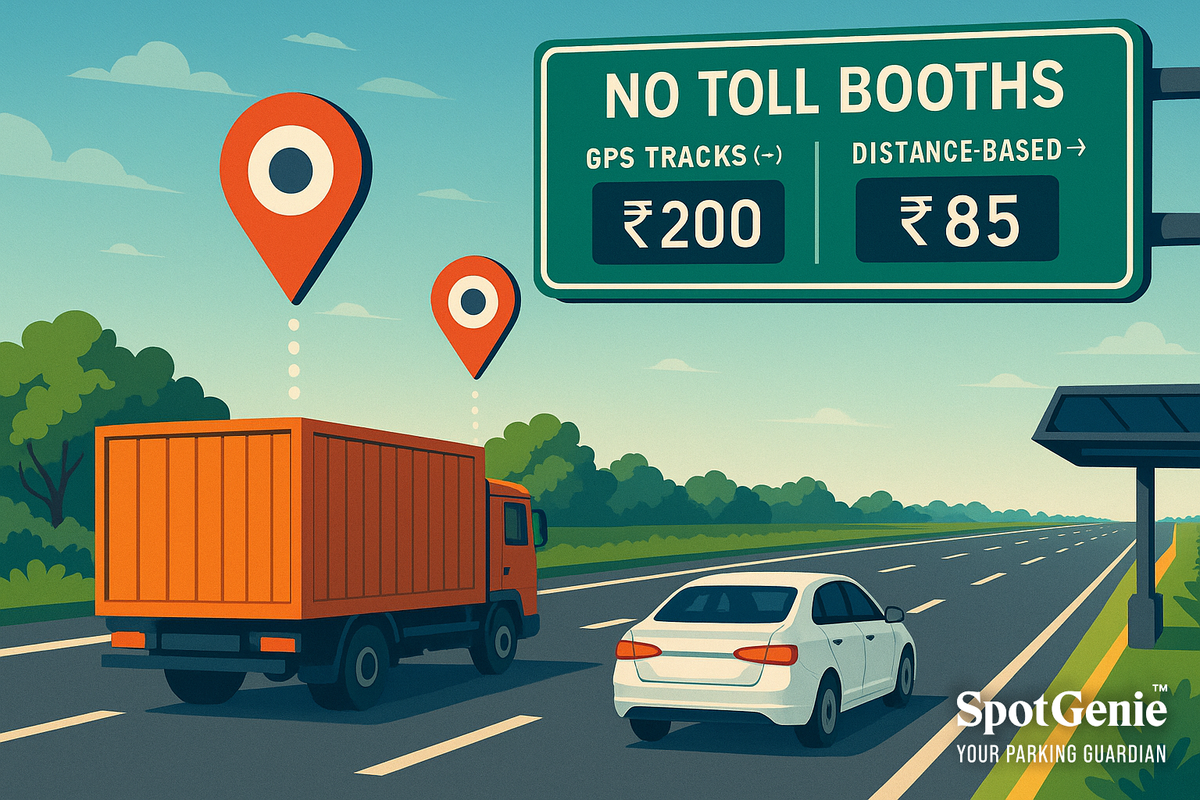Toll Booths Out, GPS In – India’s New Distance-Based Tolling Revolution
India is replacing FASTag with GPS-based tolling from July 2025. Learn how the distance-based toll revolution impacts your travel in today’s SpotGenie Gyaan.

India is replacing FASTag with GPS-based tolling from July 2025. Learn how the distance-based toll revolution impacts your travel in today’s SpotGenie Gyaan.
SpotGenie’s Opening Whisper
🧞♂️ Toll plazas may soon be a thing of the past. India is gearing up for one of its boldest digital transformations in road transport, and it begins with satellites. Starting July 2025, the government will begin phasing out FASTag and replacing it with a GPS-based tolling system. Yes, your highway tolls will now depend on how far you drive — not how long you wait in line. Let's explore what this means for travelers, transporters, and the future of commuting.
Latest Transport Tech Reform
From July 2025, the Ministry of Road Transport and Highways will launch a nationwide GPS-based toll system, beginning with commercial vehicles. This new system replaces FASTag and utilizes GNSS (Global Navigation Satellite System) to track a vehicle’s route on national highways.
Key features include:
- Installation of On-Board Units (OBUs) that track travel distance via satellite
- Distance-based toll deductions directly from the user’s digital wallet or bank account
- Elimination of physical toll booths and FASTag scanners
- Real-time tracking synced with NHAI servers via India’s IRNSS satellites
Eventually, private vehicles will also be included after a pilot run on commercial fleets is evaluated.
What It Means for You
Imagine cruising from Mumbai to Pune without ever slowing down for a toll gate. The amount you pay will be proportional to your actual highway usage — no more flat charges, no more traffic bottlenecks. Whether you’re a daily commuter, a fleet owner, or a weekend road-tripper, this system brings efficiency, fairness, and speed to your wallet and wheels.
The Deeper Jam
India’s highway network is evolving into a smart mobility grid. Congestion from toll plazas costs the country over ₹12,000 crore annually in wasted fuel and productivity. The GPS-based system aligns with the vision of Seamless Smart Transport (SST) 2030, reducing carbon emissions, enhancing transparency, and modernizing road governance. It also raises crucial debates around data ownership and travel surveillance — something we must navigate carefully.
SpotGenie’s Daily Gyaan
“The shortest path to progress isn’t a shortcut — it’s a system that measures the journey fairly.” Distance-based tolling is logic with a satellite’s eye. 🧞♂️📡
Trending Regulations & Sections
- Digital Tolling Act (2025 Draft): Framework for GPS toll implementation, privacy compliance, and commercial OBU tracking
- Section 138A: Mandates real-time toll fee display and GNSS-device calibration for all registered highway operators
City Focus: Today’s Urban Lens
Hyderabad, Jaipur, and Indore will be early testbeds for GPS tolling in July–August 2025. NHAI plans to deploy 10,000 OBUs for commercial fleets in these cities. Initial trials show a 22% reduction in highway stop-time for trucks and buses.
Voices from the Road
"Goodbye, toll lines! GPS tolling finally brings logic to road pricing."
— @TruckSmartIndia (Twitter)
"Hope they solve data security, but yes, this is the future."
— Reddit user: PayPerKM_IN
Your Move, India
Track your drive. Own your data. And most importantly — pay for what you use, not where you pause. The GPS toll system starts a new era of precision on Indian roads. Support the shift. Stay informed. Share this blog — your route just got smarter.
SpotGenie’s Sign Off
🧞♂️ From toll booths to satellites, India’s highways are entering orbit. Till next time, drive smart, drive fair — and always measure more than miles. #SpotGenieGyaan #GenieKnows
Follow us on:
🅾 Instagram |
ⓕ Facebook |
𝕏 X |
▶️ YouTube |
🟢 WhatsApp
🛰️ More from SpotGenie Gyaan – India’s Smart Road Transitions
- Lane Discipline Cameras on Mumbai Highways – Smarter Driving Ahead
- Smart Speed Cameras in Delhi – Can AI Curb Over-Speeding?
- India’s Push for Digital Vehicle Fitness Checks
- One Nation, One Ticket – India’s Unified Transport Pass Is Here
- Get SpotGenie – Smart QR Sticker for Smarter Commutes & Road Alerts
This article is part of the SpotGenie Gyaan series — decoding the digital evolution of India’s mobility, tolling, and transport future.



